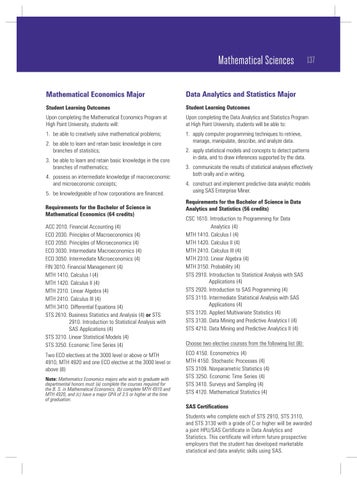Mathematical Sciences
137
Mathematical Economics Major
Data Analytics and Statistics Major
Student Learning Outcomes
Student Learning Outcomes
Upon completing the Mathematical Economics Program at High Point University, students will:
Upon completing the Data Analytics and Statistics Program at High Point University, students will be able to:
1. be able to creatively solve mathematical problems;
1. apply computer programming techniques to retrieve, manage, manipulate, describe, and analyze data.
2. be able to learn and retain basic knowledge in core branches of statistics; 3. be able to learn and retain basic knowledge in the core branches of mathematics; 4. possess an intermediate knowledge of macroeconomic and microeconomic concepts; 5. be knowledgeable of how corporations are financed. Requirements for the Bachelor of Science in Mathematical Economics (64 credits) ACC 2010. Financial Accounting (4) ECO 2030. Principles of Macroeconomics (4) ECO 2050. Principles of Microeconomics (4) ECO 3030. Intermediate Macroeconomics (4) ECO 3050. Intermediate Microeconomics (4) FIN 3010. Financial Management (4) MTH 1410. Calculus I (4) MTH 1420. Calculus II (4) MTH 2310. Linear Algebra (4) MTH 2410. Calculus III (4) MTH 3410. Differential Equations (4) STS 2610. Business Statistics and Analysis (4) or STS 2910. Introduction to Statistical Analysis with SAS Applications (4) STS 3210. Linear Statistical Models (4) STS 3250. Economic Time Series (4) Two ECO electives at the 3000 level or above or MTH 4910, MTH 4920 and one ECO elective at the 3000 level or above (8) Note: Mathematics Economics majors who wish to graduate with departmental honors must (a) complete the courses required for the B. S. in Mathematical Economics, (b) complete MTH 4910 and MTH 4920, and (c) have a major GPA of 3.5 or higher at the time of graduation.
2. apply statistical models and concepts to detect patterns in data, and to draw inferences supported by the data. 3. communicate the results of statistical analyses effectively both orally and in writing. 4. construct and implement predictive data analytic models using SAS Enterprise Miner. Requirements for the Bachelor of Science in Data Analytics and Statistics (56 credits) CSC 1610. Introduction to Programming for Data Analytics (4) MTH 1410. Calculus I (4) MTH 1420. Calculus II (4) MTH 2410. Calculus III (4) MTH 2310. Linear Algebra (4) MTH 3150. Probability (4) STS 2910. Introduction to Statistical Analysis with SAS Applications (4) STS 2920. Introduction to SAS Programming (4) STS 3110. Intermediate Statistical Analysis with SAS Applications (4) STS 3120. Applied Multivariate Statistics (4) STS 3130. Data Mining and Predictive Analytics I (4) STS 4210. Data Mining and Predictive Analytics II (4) Choose two elective courses from the following list (8): ECO 4150. Econometrics (4) MTH 4150. Stochastic Processes (4) STS 3109. Nonparametric Statistics (4) STS 3250. Economic Time Series (4) STS 3410. Surveys and Sampling (4) STS 4120. Mathematical Statistics (4) SAS Certifications Students who complete each of STS 2910, STS 3110, and STS 3130 with a grade of C or higher will be awarded a joint HPU/SAS Certificate in Data Analytics and Statistics. This certificate will inform future prospective employers that the student has developed marketable statistical and data analytic skills using SAS.
